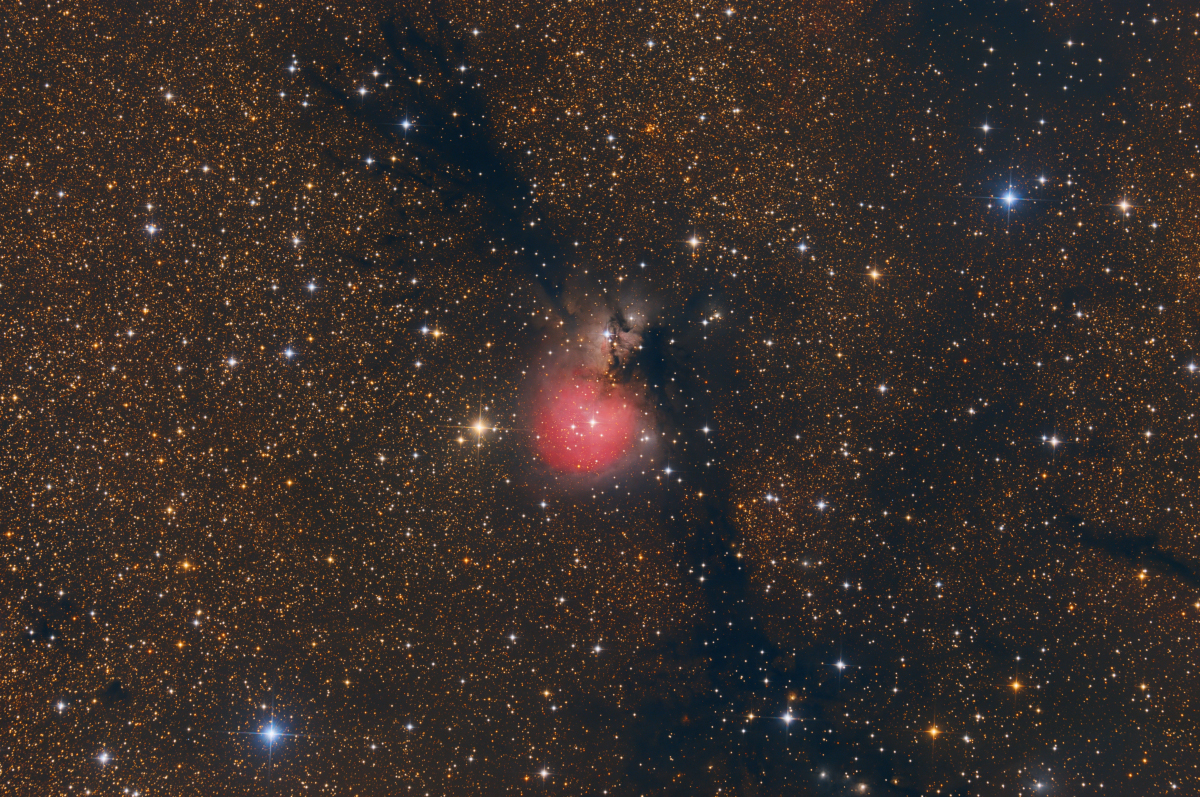
[back] Sh2-82 (Little Trifid Nebula) in Sagitta
Higher resolved image / höher aufgelöstes Bild (7322 x 4865 Pixel)

|
(c) 2022 All astro photo images are copyrighted. They may not be used or reproduced without explicit written permission from the authors. |
|
300' |
|
About this Image / Über dieses Bild
| CCD: | ZWO ASI094MC Pro |
| Image Type, Orientation: | RGB-HaOIII-Composite, North is at 12:15 h |
| Exposure time: | R,G,B: 69x300 sec., HaOIII: 19x300 sec., all 1x1 bin (7:20h total) |
| Exposure date: |
June 26th..July 06th 2022 |
| Location: | Capella Observatory at Skinakas, Crete/Greece, robotic exposure (with babysitting from Bad Arolsen/Germany) |
| Filter: | Internal RGB-Filter and STC Astro Duo-Narrowband Filter |
| Instrument: | Ganymed 60cm-Hypergraph in primary focus (f=1840 mm) |
|
Image seeing (FWHM): |
1.8" (influenced by high wind loads and not yet final pier fix) |
| Photographer: | Josef Pöpsel, Frank Sackenheim, Stefan Binnewies |
| Remarks: |
The "Little Trifid Nebula" or "Little Cocoon Nebula" (see also M 20 and IC 5146) was already a target for Ganymede. This image was taken in secondary focus 13 years before the shot above. Thanks to the significantly smaller pixels of the camera used for the picture above, the images are quite comparable in terms of details, although the upper image was taken at only a third of the focal length in primary focus. Because the cameras share the same chip size (full frame), the field of view of the above image is significantly larger due to the reduced focal length. Especially in the 100% version you can get lost in the tens of thousands of visible stars of the Milky Way. Thirteen years ago, a nine-fold mosaic would have been necessary for this. Progress in the camera sector makes it possible... |
|
Bemerkungen: |
Der „kleine Trifid-Nebel“ oder auch „kleine Kokon-Nebel“ (siehe auch M 20 und IC 5146) stand für Ganymed schon mal auf dem Programm. 13 Jahre vor der Aufnahme oben entstand diese Aufnahme im Sekundärfokus. Dank der deutlich kleineren Pixel der für die Aufnahme oben eingesetzten Kamera sind die Bilder bzgl. Details durchaus vergleichbar, obwohl oberes Bild bei lediglich einem Drittel der Brennweite im Primärfokus entstand. Wegen der gleichen Chip-Größe (Vollformat) der Kameras ist das Gesichtsfeld aufgrund der reduzierten Brennweite aber deutlich größer. Gerade in der 100%-Version kann man sich in den zig-tausend sichtbaren Sternen der Milchstraße verlieren. Vor 13 Jahren wäre hierfür noch ein Neunfach-Mosaik nötig gewesen. Der Fortschritt im Kamera-Bereich macht’s möglich... |
Back to the Diffuse Nebulae Overview / Zurück zur Diffuse-Nebel-Übersichtsseite